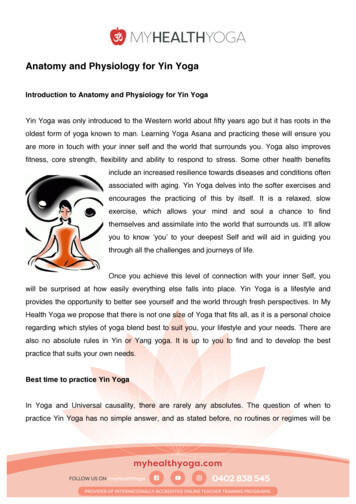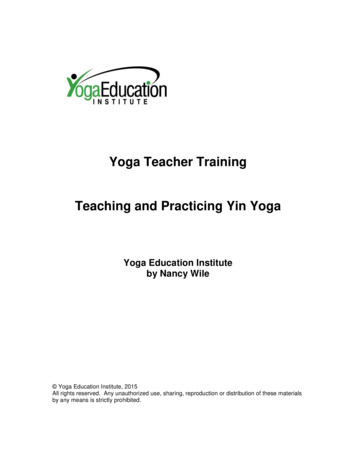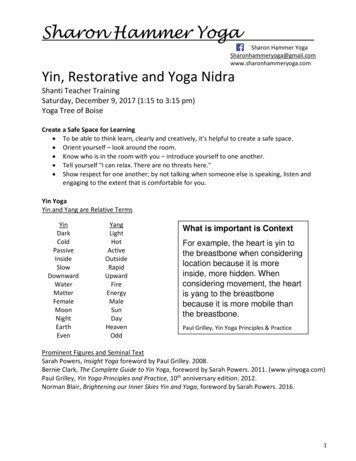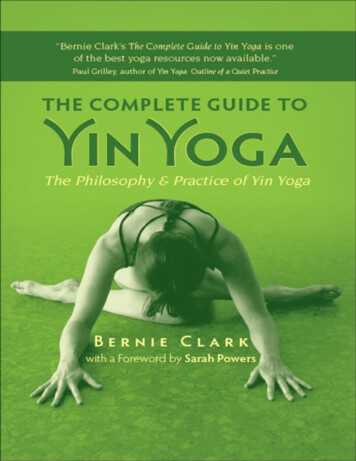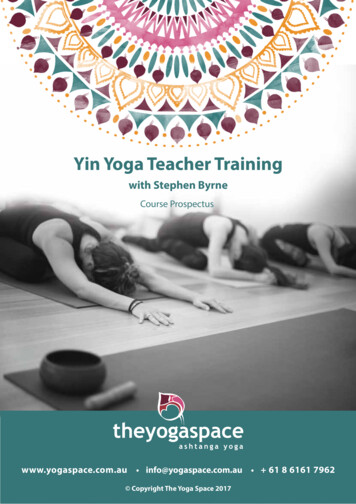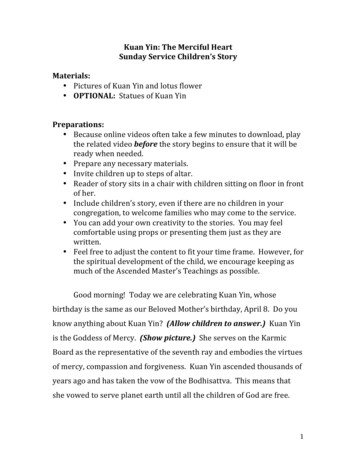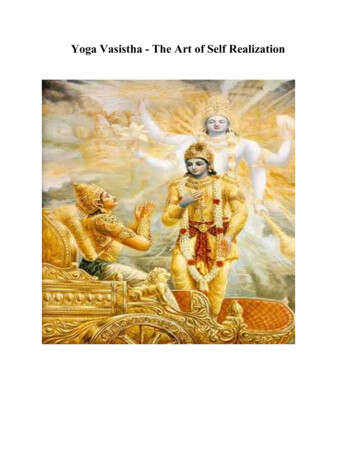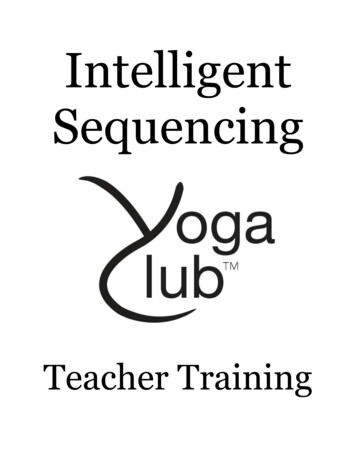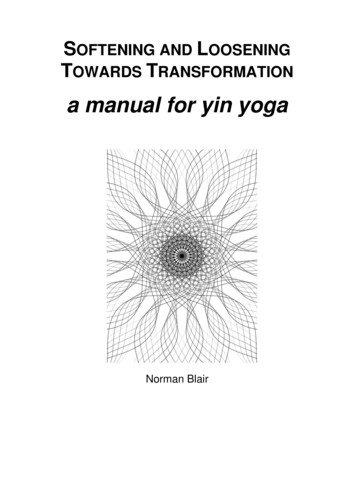
Transcription
SOFTENING AND LOOSENINGTOWARDS TRANSFORMATIONa manual for yin yogaNorman BlairNorman Blair
CONTENTSThe past of yinThe defining of yinGuides to practicingThe human bodyHeart and mindThe energetic bodyPracticing at home/Tips for teachingPossibilities of yin yogaThe postures of yinResources for yin yogaOn breath and breathingInterview with Sarah PowersBusyness is lazyness/Reggie RayThe six stages/Charlotte Joko BeckPoetry and poemsBeing healthy/being happy108 things I learnt at Gaia House2page 3page 5page 8page 10page 14page 18page 22page 26page 28page 30page 31
THE PAST OF YINMahabharata14.48“Some assert the primacy of meditation, other wise menthat of sacrifice, and still others that of giving gifts. Someassert the existence of everything, while others deny thatanything exists. With so much agreement regardingDharma leading in so many directions, we becomebewildered, O god supreme, unable to reach any certainty.”Yoga Sutras2.2“Great is the matter of birth and death; impermanencesurrounds us. Be aware each moment; do not waste yourlife. Yoga's purpose is to cultivate the experience ofequanimity and to unravel the causes of negativity.”Shankaracharya8th-century philosopher“Yoga asana is that in which meditation flowsspontaneously and ceaselessly, not that which destroyshappiness.”Tilopa11th-century teacher“Do nothing with the body but relax.”Hatha Yoga Pradipika1.66“Anyone who practices will obtain siddhis but withoutpractice no one can obtain anything. Yoga is not masteredby merely reading books. Success in yoga is not obtainedby wearing the dress of the yogi or by talking about them.Practice alone brings success, there is no doubt aboutthat.”William James“Each of us literally chooses, by his way of attending toth19 -century psychologist things,what sort of universe he shall appear to himself toinhabit”Krishnamacharya“(Janu Sirsasana) one can stay with the forehead on theknee for between five minutes and half an hour.”Yoga Makaranda 1935Sri K Pattabhi Jois“Some say that practitioners should stay in Sirsasana foronly two to five minutes; otherwise harm could come tothem. It must be stressed, however, that this is not correct,as the following scriptural saying attests: ‘Yama matramvashe nityam (we can dwell in sirsasana for three hours).’”Yoga Mala 19623
BKS Iyengar“Supta baddhakonasana if you feel any strain whilegetting into the pose, use two bolsters instead of one with practice increase the duration to 5-10 minutes.”Yoga: The path to holistic health 2001Biff Mithoefer“The heart of practice itself is not in the structure or dogmaor even in the postures themselves. It is in our experienceof the practice . Yoga is not a system to change us; it is acelebration of who we really are.”Sarah Powers“Unless you are training the mind, it’s not yoga — yoga isabout being free on all levels.”Paul Grilley“I have had no visions or clairvoyance about the future ordiscovered if there is a god. My progress is primarily that Ienjoy sitting, I enjoy being calm, I can hear the subtlesounds of the inner world. I am no longer as ambitious. I donot think I have arrived at a high spiritual state but it is animprovement from where I was.”Moby“Yoga has certainly turned the volume down on the moredesperate thoughts.”I first wrote this manual in 2007; since then it has changed a lot. Each subsequent yearI have altered and evolved its contents. I first did a downwards dog in 1991 — sincethen that has changed a lot. What was a great challenge has become much morecomfortable. This practice of yoga has many variations and versions — and of coursehas changed a lot: from dreadlocked mystics sitting in a Himalayan cave, it is now aneveryday technique in mainstream health centres and gyms.As these quotes from the Mahabharata to Moby clearly demonstrate, there aredifferent ways to practice yoga. One researcher has stated that “hatha yoga postureswere held for a long time” (Mark Singleton). When practitioners were advised byKrishnamacharya to hold janu sirsasana for up to half an hour, he was also suggestingthey hold their breath during this time. Paul Grilley talked of “yin is the classic way ofpracticing yoga”. However, this is debatable as many hatha yoga systems emphasisebandhas and drishti which are not prominent in a yin yoga practice. And it is commonfor teachers to claim that their system is ‘classical’ as a way of establishingauthenticity.The original postures of modern yin yoga came from Paulie Zink, a martial arts teacherin Los Angeles. Paul Grilley studied with him in 1987 and then taught Sarah Powerswho attended his class after her morning dynamic/ashtanga practice. In 1990 Paul firstmet Dr Hiroshi Motoyama who has subsequently been influential on both his andSarah’s teachings.Paul had been calling this ‘Taoist yoga’ which reflected his own background andinterests. But when Sarah started teaching this practice in 1996, she called it ‘yinyoga’: this is what it has become popularly known as. In 2002 Paul published his bookYin Yoga — outline of a quiet practice and Sarah first taught it at Triyoga in London.4
Since then, both have brought out DVDs and taught widely across the world. My firstyin yoga class was in November 2001 and it was at that Triyoga workshop in July 2002that I met Sarah Powers. I began teaching the long yin sessions in February 2003 andattended a training jointly taught by Paul and Sarah in January 2004.This is some of the background to yin yoga, another thread in the webs that we areweaving. However, it is important to remember the limits on how much yoga canchange a person. We are highly dependent on environmental circumstances, such asfulfilling relationships and beneficial living conditions. The failure to address theselimits can lead to unrealistic expectations and an assuming that yoga is a magic wand.Yet at the same time yoga has great potential: through its practice, there is anencouraging of embodiment so we are more able to reside in body.For many of us, there is this missing of our own being. There is a cultural emphasis ofcranium, and we are stuck in this head while neglectful of body. By residing more inbody experience, there can be a natural curiosity and possibilities for developing skillssuch as insightfulness, non-judging and kindness. Then we might become more ableto connect with what the mythologist Joseph Campbell described as “feel[ing] therapture of being alive”. And in addition, skilful exercising of body is a way of softeningthe inevitable trajectory of this tissue to tighten over time.It has to be emphasised that there are many paths towards this transformation: pathssuch as psychotherapy, bhakti devotion, different forms of meditating, group therapy.These paths will shift as we get older and become more proficient in practicing. Thistransforming could be expressed by an Emily Dickinson’s poem: “to live is so startling itleaves little time for anything else.”5
THE DEFINING OF YIN Ken Wilber“In addition to learning how to take control and assumeresponsibility, a person also needs to learn when and howto let go, to surrender, to go with the flow and not resist orfight it. Letting go versus taking control — this is, of course,just another version of being versus doing, that primordialpolarity of yin and yang that assumes a thousand differentforms and is never exhausted. It’s not yin or yang [that] isright, that being is better than doing — it’s a question offinding the right balance, the natural harmony between yinand yang that the ancient Chinese called the Tao —between doing and being, controlling and allowing, resistingand opening, fighting and surrendering, willing andaccepting.”There are numerous different philosophical and practical systems for explaining thisworld. A system with its origins in China uses the terms of yin and yang and theseterms have become part of western vocabulary. Their essence is that everything hastwo qualities — yin and yang — and these qualities are always in relationship to eachother (so what has been yin can become yang and what has been yang can becomeyin). We could generalise and describe yang as bright, warm, soft, moving andchanging — and yin as dark, cold, hard, solid and unchanging. An example of yang isa warm, bright, open hilltop — and an example of yin is a cool, dark, hidden cave. Thesunnier side of a hill is yang, the more shaded side is yin. In body terms, below thenavel is the yin part.When there is a balance, there is health and harmony — when there is imbalance,there is disease and disharmony. Most forms of modern yoga are ‘yang’ in theirapproach: dynamic and engaged, muscular and repetitive. An irony of this approach isthat there can be a marginalising of the meaning of that word ‘asana’: a standardtranslation of which is “seat” or “to be here”.This modern yoga partially reflects modern society: achieving, rushing, striving. Thereare the worryings and the wantings, all these wanderings. We are living in a world thatis dominated by yang energies where our behaviour is habitually dictated by the brain’sleft hemisphere. We hurry from here to there, trying to get somewhere or grabsomething or be someone, fuelled by caffeine and chocolate, emotionally consumingsoap operas and Crimewatch, our commuting dash supported by a diet of fast food.In this yang world, our flight/fight response is too frequently stimulated; this is thesympathetic nervous system that has been essential for survival as a species but isnow being significantly overused. It is this part of body which shouts out “fire!” andreinforces defensiveness. In contrast, the parasympathetic system tends towardsgenerosity and connection — seeing what we share rather than seeking difference anddivision. It has been termed ‘rest and digest’ or ‘tend and befriend’.One description of modern society is a “24/7 run from the tiger” — but there are veryfew actual tigers. A widespread complaint is anxiety and exhaustion, being worn downby it all. In this sympathetic system society, we see many fears and can be dominatedby left-brain hemisphere (the place of doing and recalling and judging and planning).6
By becoming more balanced, a consequence could be that instead of perceiving arope as the snake (which often we do), we can see a rope as a rope and on the rareoccasion there is a snake — we see it as a snake.Perhaps an addition of more yin practices — with their calming and cooling, slowingand surrendering — could help in a small way to resolve this modern unease: more atrest in the natural default setting of the parasympathetic nervous system where therecan be an attitude of relaxed acceptance and a cultivating of gratitude.YIN AND YANGThe following may help to explain these concepts of yin and yang.YINInnerSlowerCoolerDarkerConnective erSoftSadnessFemaleBeingnessWilling acceptanceReceptive and allowingAutumn/winterPaschmittonasanaChild’s poseSlow and steadyRight uscular leEvolutionInspiration towards improvementDynamic and engagingSpring/summerPurvottanasanaDown dogRhythmical and repetitiveLeft brainSympatheticAs Ken Wilber said, it’s not that one is better (or worse) — it’s about bringing intobalance, being in balance. And by being in balance, we can see more clearly: movingfrom an experience of fragmentation to a place of focus where instead of agitation,there is awareness; rather than confusion, there is clarity. This awareness and claritycan help us to work out what works — what is most beneficial to us in living our lives.We can realise for ourselves that crucial balancing between engagement and ease,appreciating and action.Of course, there are dangers of yin yoga being just another brand in the market —another piece of skilful marketing. The yoga market has numerous brands: anusarayoga, ashtanga yoga, Bikram yoga, car-crash yoga, core power yoga, dynamic flowyoga, forest yoga, hatha yoga, hot yoga, hot yoga barre, hot yoga by candlelight,Iyengar yoga, jivamukti yoga, Jois yoga, Kashmiri yoga, kundalini yoga, power yoga,7
quantum yoga, restorative yoga, Scaravelli-inspired yoga, Sivananda yoga, soya yoga,sports yoga, viniyoga, yin yoga, yogafit, yogapilates (two of those are made up —only two though).PRACTICING AND LIVINGThe boundaries can deepen, the labels becoming stuck, the sects institutionalising: apractice of liberation becomes the dogma of division. As Dr Motoyama has stated: “Weneed to let go of our sectarian neuroses.” The key is: how can practice help us in livingour lives — and what works for one person does not necessarily work for anotherperson and what works at one stage of life does not necessarily work in another stage.Does this practice encourage qualities such as insightfulness and kindness? And if itdoes not, then we need to either change how we are practicing or change the practiceitself. This requires an ability to look at our life without sentimentality, exaggeration oridealism: to have integrity and intelligence.When practicing yin yoga, phrases that describe this experience are terms such asmelting, unfolding, releasing, yielding, centring, easing, internalising, feeling, slowing,surrendering, merging, sinking, allowing, pouring, softening, calming, exploring Whatkind of terms describe your experience when practicing yin? Are we able to use thistool as a way of increasing vocabulary of body? Instead of ambitions, can there be anattentiveness? Can we let go of certainties like those caterpillars that said they wouldnever become butterflies? There could be delightfulness of uncertainty and there couldbe intimacy with immediacy Could we just breathe and relax and enjoy being justwhere we are 8
GUIDES TO PRACTICINGOne of the joys of yin yoga is its simplicity: you do not need a mat and it is possible topractice relatively soon after eating a meal (though that will influence how you arepracticing). There are different ways of practicing the same postures — for example,doing a wall yin practice (the shapes against a wall like dragonfly, eye of the needleand happy baby). Or doing sphinx with lower legs vertical (such as a pressing into awall). In saddle, if we place a bolster under the lower back it becomes more restorative— whereas if it is under the shoulders, there is greater emphasising of the lumbar areaand its associated meridians (such as the stomach and kidney).There is neither a list of ever more complicated postures (there are about 30 poses)nor beginner/intermediate/advanced practices: you just get on and do it. The entirepractice can be succinctly summarised by seven words: “above the knees and belowthe navel”. Sarah Powers has a lovely description: “unhurried postures unstained bystriving”. There is not a list of do’s and don’ts but there are some general guidelines topracticing yin that differentiate the practice from other forms.A good start is to investigate the location of stretch and the sensation of stretch. Thelocation (place, where) is crucial because what is perhaps acceptable in one part of thebody — the hips, the thighs — is unacceptable in another part — the knees, the neck.And then there is the issue of tissue: the actual sensation of the stretch. If thesensation is burning or sharply stabbing or electrical or if it is particularly intense in asmall area, then this can indicate overstretching and damaging of tissue. If thesensation is more dull or aching or throbbing, then this normally indicates tissue isbeing tugged in a healthy method. If a sensation that might be termed ‘tingling’ occurs,that could be a sign of damaging a nerve. Sensations being the voice of this guruwithin: an approach beautifully expressed by the novelist Tim Parks who discoveredmeditation could be an answer to his physical discomfort — “awareness has to plungeinto the flesh”. There is this raw data of sensations In becoming aware of physical sensations, let go of labels such as ‘hurt’ or ‘pain’ —because these automatically increase the mental resistance — and use more neutralphrases such as ‘intensity’. This avoids adding mental resistance to the alreadyexisting physical resistance. There is intensity without too much tension: we avoidsensations going beyond the boundaries of being bearable. We are aware of thevolume of these sensations: avoid that which is too loud and focus on subtle as well asstrong. Can there be an experiencing of sensations just with their patterns ofarising/existing/passing away? This situation of skilfully sailing the seas of sensations— so is there a quality of quietness and a sense of stillness in shapes? Is there anexperience of sustainability so we can stay without undue straining?Jon Kabat-Zinn“When you see and feel sensations you are experiencing assensations, pure and simple, you may see that these thoughtsabout the sensations are useless to you at that moment and thatthey can actually make things worse than they need be We aresimply inviting ourselves to interface with this moment in fullawareness, with the intention to embody as best we can anorientation of calmness, mindfulness, and equanimity right hereand right now.”9
The breath is a great guide — breathing as a beautiful barometer for possibilities withinbody. In yin (as nearly all forms of yoga), the emphasis is on deepening andlengthening the breath and there is also a direction of breathing into places oftightness. The length of breath is more important than the length of hamstrings, theslowness of breathing is more important than the strength of shoulders. This is not astrong ujjayi breath — there is subtlety to the style of breathing so that the only personwho can hear the breath is the person practicing. See the chapter ‘On breath andbreathing’ for more details.There is a conscious turning inward — a turning towards our current circumstances.This is an investigation of body as it actually is so we are becoming conscious ofcontent rather than a fixation on form. A guide for the yin yoga experience is beingslow and being steady — so there is softness and sustainability. We practice quietlyand gently, so present are qualities like patience, kindness and dedicated effort. Westay reasonably still in the shapes without agitation or anxiety. This has been called theGoldilocks approach: she came to the house where there were three beds — one wastoo hard, one was too soft, one was just right. So neither too hard nor too soft: themiddle way where there is an ability to sustain that stillness. In this middle way, thereare possibilities of pliancy and becoming more pliable and this helps to develop ourresilience.A writer on food described the art of cooking as practice, patience and presence. Thesame is true for the art of yoga. To be successful — to experience the potential ofsoftening and loosening — we have to take our place on the mat and get on with it:with practice, with patience, with presence.PRACTICAL GUIDELINES Relaxing: unlike the yang practices, in yin yoga we consciously relax themuscular tissue of the body: disengaging the front thighs, relaxing the feet. Thisenables us to access the yin aspect of physicality: connective tissue. We accessyin tissue through slowness and steadiness rather than rhythm and repetition.Yet in the relaxing of muscular tissue, it’s not that we just fall forwards — forexample, in forward bends there is a gentle lift before lowering: neitherlengthening nor collapsing, neither over-engaging nor flopping. At the start of apose, we could focus on stretching the skin between navel and sternum. Onoccasion, we might need to consciously engage muscular tissue: such as toprotect knees in dragonfly or to stabilise the back in sphinx. If we are verymobile in body (this is sometimes called ‘hyperflexible’), there has to be muchmore emphasis on engaging muscularity. This is a good example of therequirement for individual instructing. Time: it is suggested that the postures are held for longer than one minute andless than twenty minutes. Research indicates that there are no further physicalbenefits to be gained from holding a posture longer than twenty minutes. Anaverage length of time is five minutes — beginners might hold for shorterperiods and more experienced students for a longer time. And remember thatthe ultimate authority is the practitioner — so if you want to change posturebefore the time is up, then listen to your own experience. Yet be mindful in thatlistening and avoid rushing out just because you perceive sensations as “toostrong”: investigate that perception before acting.10
Mindful edge: each person has their own edge and this edge will be different indifferent postures and on different days. The edge should be approached slowlyand with awareness and then held without fidgeting (so there is a reasonablelevel of stillness in the shape) or trying to fix (an attitude of acceptance). Aftersome time at this place, perhaps there is a realisation that the edge may haveshifted, allowing the posture to become deeper — or a calm recognising thatyou have to actually ease away from this edge. Balance: it is important to balance the forward bends with backbending (andacknowledge there are at least 20 yin poses that are forward flexion in theirquality and much fewer that are of back extending).INFORMING GUIDELINES Letting go: letting go of wanting to be better, letting go of wanting to besomewhere else, letting go of planning tomorrow, letting go of that innerdialogue, letting of tension around the area of sensation, letting go of theshoulders, letting go of what we think we are supposed to do, letting go ofimpressing and improving, letting go of frowns and forcing, letting go of ambitionand aggression, letting go of contrasting and comparing, letting go of holdingand trying to control. In this letting go, there can be a loosening of rigid viewsthat are the enemy of intimacy. Much letting go to enable us to be here: as weactually are, in an experience of authenticity — where there is nothing to do,nowhere to go, nothing to get. Gentleness: or this might be called ‘loving-kindness’ — a great challenge for somany of us! To practice with kindness, to be gentle in how we practice, toensure that we are not forcing beyond our natural limits nor competitivelystriving. Patience: to take our time in this practice, to be liberated from hurrying here andthere. Yin is a great practice for emphasising patience simply because wespend so much time in each posture. Becoming patient in an impatient world isa very useful skill. And the practice of patience can arise from our ability to bekind. In the Buddha’s teachings, patience is one of the practices frequentlytaught.11
THE HUMAN BODYEven after much research into the human body, most of what happens in it is still amystery (that is one explanation for the changing fads in diet and exercise). Thehuman body can perhaps be best described as layers within layers, tubes within tubes,nets within nets. There are over 200 bones in the body, about 150 joints, more than600 muscles (in the face alone there are 43 distinct muscular movements which incombination can make about 3000 facial configurations which appear to havemeaning). There is great complexity of body — as well as a diaphragm of abdomen,there are also diaphragms at pelvic floor, throat and brain. There are pints of blood, dozens of organs, a network of nerves, a total of around 50—100 trillion cells. And an estimated one trillion of these cells are in the human nervoussystem. It needs to be emphasised that these cells are highly harmonious and worktogether to a great degree of co-operation: our internal landscape is very much one ofco-operating rather than competition. A general view is that there are four kinds oftissue: epithelia (for example, skin); nervous; muscle; and connective tissue which sortof holds it all together.In terms of resistance to movement (the range of motion), it is indicated by researchthat skin just causes 2%, tendon causes 10%, muscle and its fascia causes 41% andjoint capsule/ligaments cause 47%. But there is not a sharp dividing line between onetissue and the next. As an example, the fascia becomes denser and becomes tendonthat becomes bone.Connective tissue (tendons, ligaments, fascia) holds together the bones, it coats themuscles, it covers the organs. It is the most dominant tissue in the body and the mostoverlooked. It has been described as “that ubiquitous elastic-plastic, gluey componentthat invests, supports and separates, connects and divides, wraps and gives cohesionto the rest of the body” (Leon Chaitow). Though there are distinct forms of tissue in thebody, there is also significant overlap: for example, fascia can make up 30% of themass of muscle (this is why muscle is more technically referred to as ‘myofascia’).It is a misguided impression that the muscles, bones, blood system and nervoussystem are separate systems within body: everything is interconnected and all thetissues are working together. Through movement we compress, stretch and twist (thisis termed compression, tension and shear). By these impacts, the tissue can berejuvenated, massaged, hydrated — which is of course significantly beneficial to body.In the womb, connective tissue is formed before the nervous system. Connectivetissue is different from muscular tissue in density and has different properties: musclefibres are made up of living cells whereas connective tissue is non-living tissue that iscomposed of bundles of protein fibres (in ligaments and tendons, they are arranged intightly packed parallel bundles and in fascia, they form a network which is wrappingmuscles and organs). There is some blood supply and some nerves but not to theextent that exists in muscles — and this is the reason why connective tissue takeslonger to repair after injury than muscle.In anatomy books, muscular tissue is often coloured red while connective tissue iscoloured white (as an indicator of its more solid substance). And from our early 20s,the flow of fluids into this tissue diminishes which causes a gradual hardening and a12
slow tightening. This means that unless there is movement, it is almost as though thebody becomes suffocated in connective tissue. The arc of this life is from fluidity (beingyin at birth — like a baby physically unable to hold up their own head) to stiffness(being yang at death — the rigidity of rigor mortis).In yin yoga, we are allowing the deep connective tissue that surrounds hips and lowerback to be gently stretched. Each of the yin yoga postures has a particular influence onthe body: for example, butterfly is a gentle flexion of spine, a gentle external rotation ofhips and a gentle abduction of thighs (note the word ‘gentle’ amongst the anatomicalexplanations). Butterfly can also help regulate menstrual cycles. In happy baby, weneed to be sensitive in stretching when there are existing issues in the sacroiliac (SI)area. Conversely, saddle is recommended as beneficial for that area of the body. Andin that saddle, it is easier for forward bend/open hip bodies to take knees wider.Because we spend so much time sitting in chairs, there is a losing of the natural tilt ofsacrum (tilting forwards as its top follows lumbar curvature). Often the sacrum beginsto tilt backward and this can cause lower back discomfort and flattening of the lumbar.Saddle can be helpful for sacrum tilt and the SI area. And because we live in a worldwhere frequently there are feelings of helplessness and insecurity, this can causetension to the psoas musculature — postures like constructive rest and dragon couldlessen this tension. Heart opening can be helpful for the middle and upper back as wellas a way of stretching diaphragm (which assist our breathing) and could relieveheadaches. Child’s pose benefits the organs of digestion (partly through the action ofcompressing). Frog can be good for menstrual cramps.It has been suggested that long holds in stretching may encourage parasympatheticactivation partly through an influence on the vagus nerve (this is the majorparasympathetic nerve and recent studies have shown that we have an ability to alterits ‘tone’). In slowing down, we can realise the many different layers of this being.Through sustained investigation, we can begin to recognise that there are always morelayers. There is an old saying from Africa: “the one in a hurry has no blessings”.INDIVIDUALITY OF ANATOMYA popular perception amongst yoga practitioners is that if only we practice enough,then this or that posture will become available to us. However, as Paul Grilley andother anatomists have demonstrated, the skeletal structure limits stretching. Wecannot fundamentally vary the structure of our bones and the shape of our skeleton —though it has to be noted that after six months in space, some astronauts had lost upto 20% of their bone density.When the restriction on movement is arising from tight muscular tissue, Paul calls this‘tension’ and when the restriction arises from the skeletal structure, ‘compression’. Anexample of compression is when we fully straighten the elbow and essentially it isbone impacting on bone. It could be called ‘tensile restriction’ in muscles and‘compressive restriction’ in bones. Each person experiences tension and compressionin different places, as there is significant individuality within our physical structures.This is not just a matter of height and weight, it is also a matter of angles and lengths,degrees and depths. Within the practice and teaching of yoga, it is essential that thereis a conscious realisation of individuality in terms of human anatomy.13
Paul Grilley“Everyone’s bones are shaped differently — individualbones of the body conflict with the universal laws ofalignment we have to bring to yoga practice openmindedness”.An example of skeletal limitations is the angle of the femur into the pelvis and thedepth of the hip socket. Paul refers
Paul had been calling this ‘Taoist yoga’ which reflected his own background and interests. But when Sarah started teaching this practice in 1996, she called it ‘yin yoga’: this is what it has become popularly known as. In 2002 Paul published his book Yin Yoga — outline of a quiet
